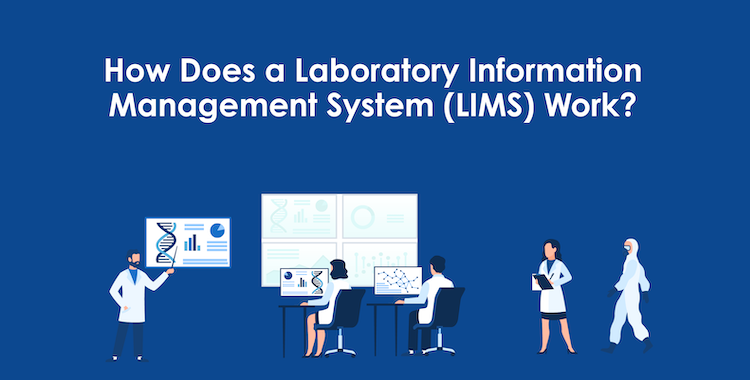
Efficient LIMS workflow management is essential for laboratories to streamline their processes, ensure data integrity, and maintain compliance with industry regulations. In this blog post, we will explore the various aspects of implementing an integrated LIMS solution that can help optimize your laboratory operations.
We will discuss how a well-designed laboratory information management system can automate workflows and manage sample metadata effectively. We will also explore the importance of real-time error detection in maintaining data integrity throughout the process.
In addition, you'll learn about control repositories and batch monitoring techniques that contribute to consistent performance across different batches. Furthermore, we'll examine regular testing procedures in manufacturing environments as part of quality assurance initiatives and adherence to regulatory standards.
Finally, we will highlight audit trails and data analysis capabilities offered by advanced LIMS systems for enhanced traceability and automated reporting. Stay tuned as we guide you through these crucial elements of effective LIMS workflow management.
Table of Contents:
- LIMS in Laboratory Organization
- Streamlining Workflows Through Automation
- Efficient Management of Samples Metadata
- Control Repositories and Batch Monitoring
- Ensuring Consistent Performance Across Different Batches
- Tracking Distribution for Efficient Resource Allocation
- Maintaining Quality Control Standards with LabWare LIMS
- Regular Testing in Manufacturing Environments
- Quality Assurance through Automated Testing Procedures
- Compliance with Industry Regulations
- Audit Trails & Data Analysis
- Enhancing Traceability with Detailed Recordkeeping
- Automated Reporting Capabilities
- FAQs in Relation to Lims Workflow Management
- What is Workflow Management in LIMS?
- What are the Four Steps in Implementing a LIMS?
- How has LIMS Contributed to Good Laboratory Management?
- Why is Workflow Important in a Laboratory?
- Conclusion
LIMS in Laboratory Organization
A Laboratory Information Management System (LIMS) is an essential application that helps laboratories maintain organization and manage various tasks. It plays a crucial role in tracking scientific data, organizing lab experiments, and ensuring compliance with laboratory best practices. In this section, we will discuss how LIMS streamlines workflows through automation and efficiently manages metadata.
Streamlining Workflows Through Automation
One of the significant advantages of implementing a LIMS is its ability to automate repetitive tasks within the laboratory environment. By automating processes such as sample registration, result entry, and report generation, labs can significantly reduce manual labor requirements while increasing overall efficiency. This not only saves time but also minimizes human errors that may occur during manual data handling.
In addition to process automation, many LIMS solutions offer customizable workflow management features that allow users to define their specific workflows based on individual needs or industry standards. These tailored workflows help ensure consistency across all stages of the testing process by guiding staff members through each step according to predefined rules or guidelines.
Efficient Management of Samples Metadata
A critical aspect of any laboratory's operations involves managing vast amounts of information related to samples, from collection details such as date/time/location to test results and associated analyses. A robust LIMS enables efficient storage, retrieval, and analysis of these vital pieces of information by providing comprehensive database structures designed specifically for managing sample metadata.
- Data Standardization: With a centralized system like LabWare's sample management software, laboratories can standardize data formats across different departments or even multiple locations. A centralized system like LabWare's sample management software makes sure that all users can comprehend the information stored in the system, helping to improve cooperation and decision making.
- Search & Retrieval: LIMS offers advanced search capabilities that enable users to quickly locate specific samples or related data based on various criteria such as sample ID, test type, or collection date. This saves time by eliminating manual searches through paper records or spreadsheets while also reducing the risk of misplacing important documents.
- Data Security: Implementing a LIMS helps protect sensitive laboratory data from unauthorized access by employing user authentication measures and role-based permissions. Additionally, many systems offer secure backup options to ensure data integrity in case of hardware failures or other unforeseen events.
In conclusion, implementing a Laboratory Information Management System (LIMS) significantly enhances laboratory organization by streamlining workflows through automation and efficiently managing sampledata. By adopting this technology, labs can improve their overall efficiency, reduce errors, and maintain compliance with industry best practices.
Sample handling and error detection are essential for any LIMS workflow management system, as it allows for real-time tracking of sample status and maintenance of data integrity. To ensure consistent performance across different batches, Control Repositories and Batch Monitoring can be used to track distribution efficiently.
Key Takeaway: A Laboratory Information Management System (LIMS) helps laboratories maintain organization and manage various tasks by automating repetitive processes, customizing workflows, and efficiently managing sample metadata. LIMS streamlines workflows through automation, reduces manual labor requirements while increasing overall efficiency, standardizes data formats across different departments or locations, offers advanced search capabilities for quick retrieval of specific samples or related data based on various criteria such as sample ID or test type while ensuring data security with user authentication measures and role-based permissions.
Control Repositories and Batch Monitoring
By utilizing a LIMS, scientists can ensure consistent performance across different batches while efficiently tracking distribution among lab members for optimal resource allocation. This section will look into the importance of control repositories, batch monitoring, and how a LIMS contributes to maintaining quality control standards.
Ensuring Consistent Performance Across Different Batches
In many laboratory settings, controls are produced in large quantities or batches. These controls serve as reference materials that help validate the accuracy of test results by providing known values against which experimental data can be compared. To ensure consistency, it is essential to implement a LIMS system that monitors the production process of each batch.
A well-designed LIMS system allows scientists to monitor various parameters related to each batch's production, including raw material sources, processing conditions, and storage conditions, ensuring that any variations are detected promptly. Furthermore, these systems facilitate trend analysis over time so that potential issues can be identified before they escalate into more significant problems affecting multiple batches.
Tracking Distribution for Efficient Resource Allocation
- Sample management: A key feature of an effective LIMS is its ability to manage sample inventory effectively. This includes tracking individual samples' locations throughout the laboratory environment and recording information on usage patterns - all critical aspects when allocating resources efficiently.
- Data accessibility: With comprehensive recordkeeping capabilities provided by modern LIMS solutions like LabWare's software suite (LabWare LIMS), scientists can access data on control batch distribution and usage in real-time. This enables them to make informed decisions about resource allocation, ensuring that no single lab member is overburdened or left without necessary materials.
- Optimizing workflows: By providing insights into the flow of controls throughout a laboratory, a LIMS system helps identify bottlenecks and inefficiencies in current processes. As a result, labs can optimize their workflows for maximum productivity while minimizing waste.
In summary, control repositories and batch monitoring are crucial aspects of maintaining quality control standards within laboratories. A robust Laboratory Information Management System (LIMS) not only ensures consistent performance across different batches but also allows for efficient tracking of distribution among lab members - ultimately contributing to better resource allocation and overall laboratory efficiency.
Maintaining Quality Control Standards with LabWare LIMS
Achieving optimal quality control standards requires continuous monitoring of various parameters associated with the production process. With LabWare's comprehensive suite of tools designed specifically for managing these tasks effectively (LabWare LIMS Quality Control module), laboratories can ensure that they consistently produce high-quality controls meeting regulatory requirements while maximizing operational efficiency at every stage.
The benefits offered by LabWare's advanced solutions extend beyond just sample management; they also provide valuable insights into trends affecting your organization's performance and allow you to proactively address potential issues before they escalate further down the line. Don't let subpar quality control practices hinder your laboratory operations any longer, invest in an industry-leading solution like LabWare today.
Control Repositories and Batch Monitoring allow for consistent performance across different batches, as well as efficient resource allocation by tracking distribution. To ensure quality assurance in manufacturing environments, automated testing procedures are necessary to meet industry regulations.
Key Takeaway: A Laboratory Information Management System (LIMS) is essential for managing control repositories and monitoring batch performance within laboratories. It ensures consistent performance across different batches, tracks distribution for efficient resource allocation, and helps identify bottlenecks in current processes to optimize workflows. LabWare's LIMS solutions provide comprehensive tools to maintain quality control standards while maximizing operational efficiency at every stage.
Regular Testing in Manufacturing Environments
The system enables streamlined workflows and ensures proper documentation for audit purposes while maintaining high-quality standards throughout production stages. In this section, we will discuss the importance of regular testing in manufacturing environments and how a LIMS can contribute to achieving these goals.
Quality Assurance through Automated Testing Procedures
In any manufacturing environment, quality assurance is crucial to ensure that products meet industry standards and customer expectations. One way to achieve this is through automated testing procedures, which help identify potential issues early on before they escalate into more significant problems. A LIMS plays an essential role in automating these procedures by managing test schedules, tracking results, and generating reports for analysis.
- Test scheduling: A LIMS allows you to create custom test schedules based on your specific requirements or industry regulations. This ensures that all necessary tests are performed at the right time without delays or missed deadlines.
- Result tracking: As tests are completed, a LIMS captures the data generated from each run and stores it securely within its database. Real-time information regarding product quality at any stage of production is easily accessible to stakeholders through the use of a LIMS.
- Report generation: With built-in reporting capabilities, a LIMS simplifies the process of analyzing test data by automatically generating detailed reports highlighting key performance indicators (KPIs), trends, and areas requiring improvement.
Compliance with Industry Regulations
Beyond ensuring product quality, regular testing in manufacturing environments is also necessary for maintaining compliance with industry regulations. These guidelines often require manufacturers to conduct specific tests and maintain detailed records of their results. A LIMS can help you stay compliant by automating these processes and providing a centralized platform for managing all related documentation.
- Automated recordkeeping: A LIMS automatically captures test data, reducing the risk of human error associated with manual data entry. The system's accuracy and completeness is always assured due to its automated record-keeping.
- Audit trails: With comprehensive audit trail capabilities, a LIMS tracks every action performed within the system, from sample receipt to final disposition. This level of traceability makes it easy to demonstrate regulatory compliance during audits or inspections.
- Data security: To protect sensitive information from unauthorized access or tampering, a LIMS employs robust security measures such as user authentication protocols and encryption technologies. By safeguarding your data against potential threats, you can maintain trust among customers and regulators alike.
In conclusion, a LIMS can help manufacturing environments achieve quality assurance and regulatory compliance through automated testing procedures, streamlined workflows, and centralized documentation management.
Periodic testing in fabrication milieus is a fundamental element of quality control, helping to make certain that products adhere to safety and sector norms. Audit trails and data analysis provide further insight into the production process by tracking changes over time and enabling automated reporting capabilities.
Key Takeaway: A LIMS can help manufacturing environments achieve quality assurance and regulatory compliance through automated testing procedures, streamlined workflows, and centralized documentation management. It enables manufacturers to create custom test schedules based on specific requirements or industry regulations while tracking results in real-time for analysis. The system's accuracy is always assured due to its automated record-keeping, comprehensive audit trail capabilities, and robust security measures protecting sensitive information from unauthorized access or tampering.
Audit Trails & Data Analysis
An effective LIMS must be capable of producing comprehensive audit trails to accurately track sample management, from intake to results analysis and interpretation. These records document every aspect of sample management, specifically storage and consumption to results analysis and subsequent data interpretation. By maintaining detailed documentation, LIMS not only helps laboratories comply with regulatory requirements but also contributes to improved efficiency through better workload management and automated reporting.
Enhancing Traceability with Detailed Record keeping
In today's highly regulated laboratory environment, traceability is essential for ensuring compliance with industry standards such as FDA 21 CFR Part 11, ISO 17025, or GLP/GMP guidelines. A robust LIMS solution provides a secure means of tracking all activities related to samples, including their collection, processing, testing, storage conditions, and disposal. This level of detail ensures that any discrepancies or issues can be quickly identified and addressed while minimizing potential risks associated with non-compliance.
Furthermore, advanced LIMS systems offer features like electronic signatures and time stamped entries which add another layer of security by verifying user identities during crucial steps in the process. With these capabilities in place, laboratories can have greater confidence in the accuracy and reliability of their data.
Automated Reporting Capabilities
Beyond merely documenting each step within a sample's lifecycle, modern LIMS solutions also streamline workflows by automating the reporting process. By generating customizable reports, these systems can save valuable time and resources that would otherwise be spent on manual data entry and analysis.
- Standardized Reports: LIMS software often includes a library of pre-built report templates designed to meet common regulatory requirements or industry-specific needs. These standardized formats ensure consistency across all documentation while simplifying the reporting process for lab personnel.
- Customizable Templates: For laboratories with unique reporting needs, many LIMS solutions offer the ability to create custom report templates tailored to specific requirements. This flexibility allows labs to generate targeted reports that provide actionable insights into their operations and performance metrics.
- Scheduled Reporting: To further streamline workflows, some LIMS platforms enable users to schedule automated report generation at predetermined intervals (e.g., daily, weekly, monthly). This feature ensures timely delivery of critical information without requiring constant oversight from laboratory staff members.
Incorporating comprehensive audit trails and automated reporting capabilities within a Laboratory Information Management System not only helps maintain compliance with stringent regulations but also enhances overall efficiency by reducing manual workloads. As a result, laboratories equipped with advanced LIMS solutions are better positioned to focus on their core competencies - conducting high-quality research and delivering accurate results in a timely manner.
Key Takeaway: An effective LIMS system must have comprehensive audit trails to track sample management accurately, from intake to results analysis and interpretation. Detailed record-keeping enhances traceability, ensuring compliance with industry standards while minimizing potential risks associated with non-compliance. Automated reporting capabilities streamline workflows by generating customizable reports that save valuable time and resources spent on manual data entry and analysis.
FAQs in Relation to LIMS Workflow Management
What is Workflow Management in LIMS?
Workflow management in LIMS refers to the systematic organization and automation of laboratory processes, from sample handling to data analysis. This helps streamline operations, reduce errors, maintain compliance with industry regulations, and improve overall efficiency. Workflow management tools within a LIMS enable laboratories to customize their workflows according to specific requirements.
What are the Four Steps in Implementing a LIMS?
The four key steps in implementing a LIMS include:
- Defining clear objectives and requirements for your laboratory's needs
- Selecting an appropriate LIMS vendor
- Configuring and customizing the system based on your lab's unique processes
- Training staff members on how to use the new system effectively
How has LIMS Contributed to Good Laboratory Management?
LIMS contributes significantly to good laboratory management by automating repetitive tasks, reducing human error, maintaining data integrity, ensuring regulatory compliance, enhancing traceability through detailed recordkeeping, streamlining workflows for improved efficiency and productivity while providing real-time information on sample status throughout various stages of processing.
Why is Workflow Important in a Laboratory?
An efficient workflow is crucial in a laboratory as it ensures smooth functioning of all processes while minimizing bottlenecks or delays. A well-designed workflow enhances productivity by optimizing resource allocation, reducing errors and rework, maintaining data integrity, ensuring consistent performance across different batches of samples, and facilitating compliance with industry regulations.
Conclusion
In conclusion, LIMS Workflow Management is an essential component of any laboratory organization. By streamlining workflows through automation, efficient management of sample metadata, control repositories, and batch monitoring, regular testing in manufacturing environments, audit trails, and data analysis, it improves productivity and ensures compliance with industry regulations.
At LabWare, we understand the importance of reliable data management integrated into laboratory information management systems (LIMS). We offer an integrated LIMS solution that guides users step-by-step through lab processes and routine tasks while managing records for project progress. Contact us today to learn more about how our automated processes can help improve your lab operations.
Call-to-Action: Improve your lab's workflow with LabWare's Integrated LIMS Solution. Contact us today!
















